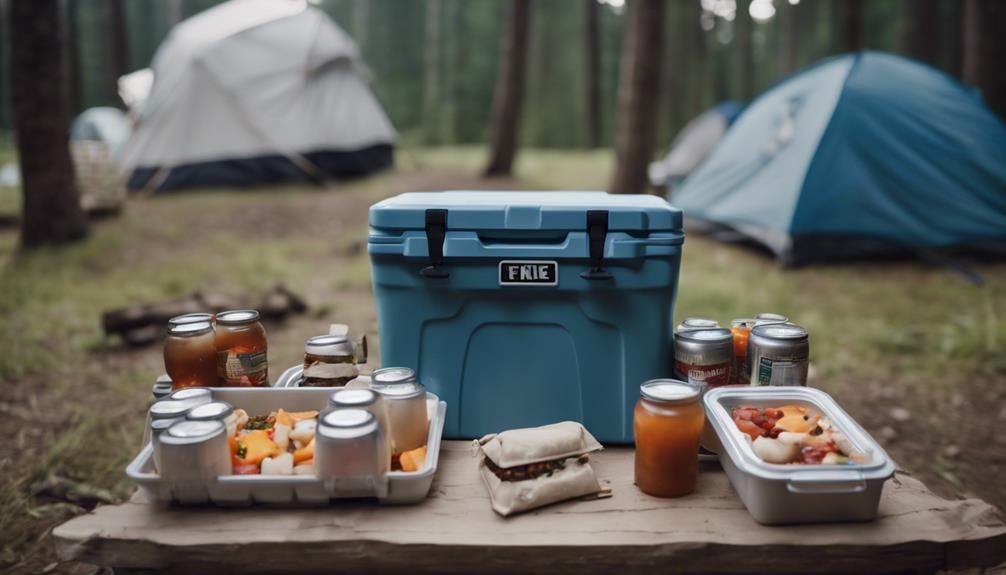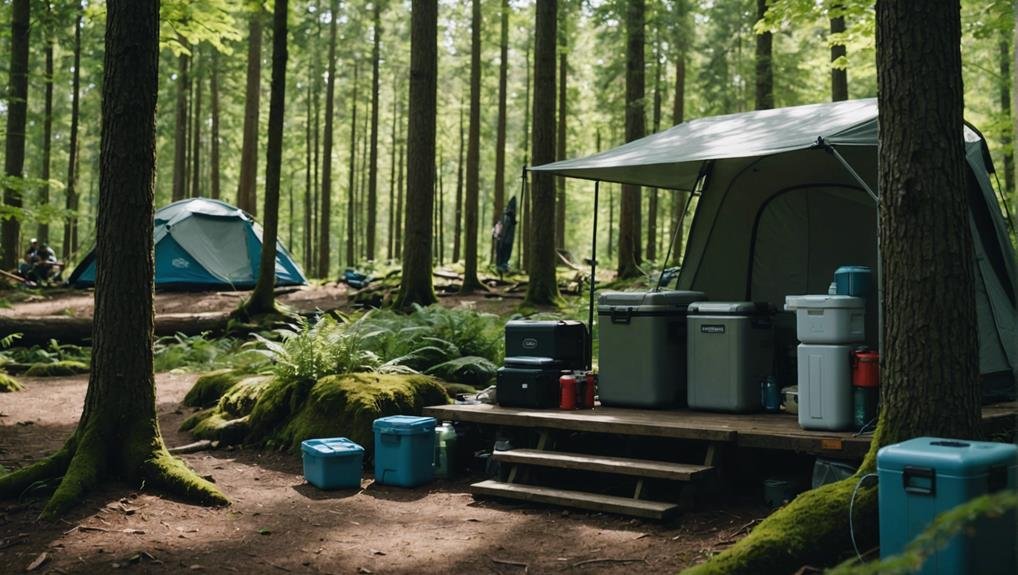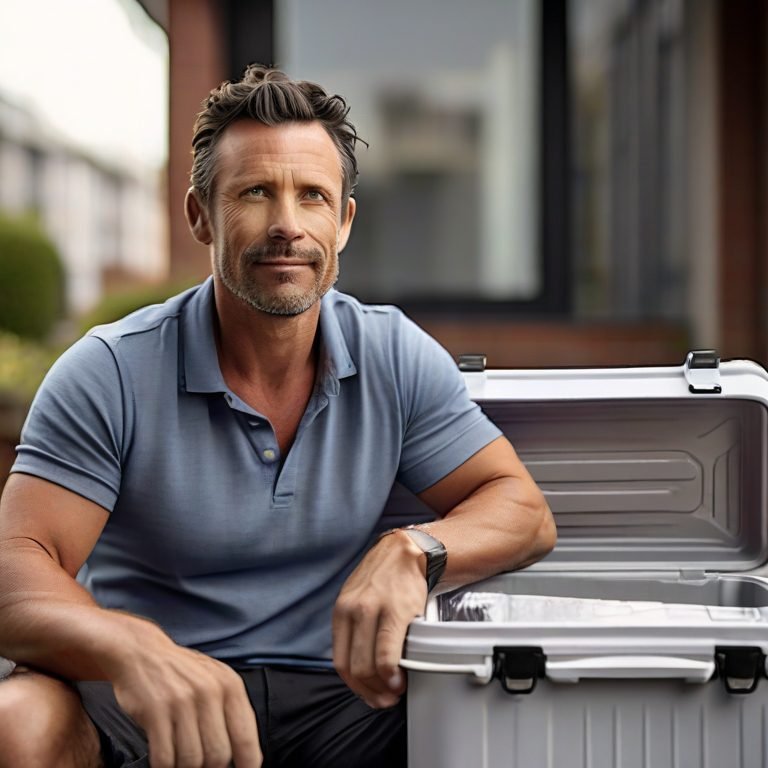As you pack for your next camping trip, you’re likely considering how to keep your food cold and fresh in the great outdoors. Choosing a high-quality cooler is just the start.
You might already know a bit about pre-freezing your items or using ice packs, but are you employing these methods most effectively? Maintaining the organization within your cooler and carefully managing how often you open it can greatly enhance its efficiency.
Let’s explore these strategies in more detail, and perhaps you’ll discover a few new tips to perfect your camping food storage system. Are you ready to elevate your outdoor culinary experience?
Key Takeaways
- Use a high-quality cooler like YETI Tundra 65 or Coleman X-Treme to ensure superior ice retention.
- Pre-freeze perishable food items and use them as additional ice packs.
- Invest in large, high-quality freeze packs and place them strategically within the cooler.
- Organize your cooler efficiently, keeping perishables at the bottom and frequently used items on top.
- Minimize opening the cooler by keeping beverages in a separate container and planning what to grab beforehand.
Select a High-Quality Cooler
Choosing the right cooler, such as the YETI Tundra 65 with its three-inch thick insulated walls, is crucial for keeping your food cold throughout your camping trip.
When considering your options, look for coolers designed for superior ice retention and constructed from high-quality, non-hazardous materials to guarantee food safety and durability.
For longer trips, you might consider the Coleman X-Treme, which boasts a 70-quart capacity and insulated walls capable of keeping contents cold for up to five days. This type of cooler is perfect for extended stays in the great outdoors, where a grocery store isn’t just around the corner.
Alternatively, a portable car fridge offers a convenient, mess-free cooling solution. It runs on multiple power sources, allowing you to maintain excellent cooling without relying solely on ice packs.
However, if you prefer traditional coolers, integrate freeze packs that stay cold for up to 48 hours, reducing the frequency of ice replenishment. Lastly, organizing with a separate beverage cooler can greatly enhance your main food cooler’s efficiency.
By limiting the number of times the food cooler is opened, you’ll maintain a more consistent internal temperature, ensuring your perishables stay fresh and safe throughout your adventure.
Pre-Freeze Your Supplies
To maximize cooler efficiency and extend the freshness of your food, consider pre-freezing perishable items like meats and dairy before heading out camping.
This technique guarantees that perishable supplies maintain a chilled temperature longer, ultimately enhancing your camping experience by keeping your meals fresh and safe.
When you pre-freeze your food, these items double as additional ice packs. This reduces the need to pack excess ice, saving space and keeping other food items chilled longer. It’s a simple step that boosts the overall efficiency of your cooler.
Moreover, it is essential to store your perishable supplies in airtight containers before freezing them. This prevents moisture from seeping in as they thaw, maintaining food quality and avoiding sogginess.
You’ll appreciate this more when you open your cooler and find your food still in excellent condition, just as you packed it.
Utilize Ice Packs Effectively

While camping, you can keep your food cold and fresh longer by effectively utilizing ice packs. Investing in large, non-hazardous freeze packs guarantees your perishable items stay chilled without the constant hassle of draining water from melted ice.
These packs often maintain their cooling capabilities for up to 48 hours, making them perfect for longer camping trips where food safety and freshness are paramount. Here are some tips to optimize the use of ice packs during your adventures:
- Choose High-Quality Freeze Packs: Opt for freeze packs known for their prolonged cooling effects, which enhance the insulation within your cooler.
- Layer Smartly: Position freeze packs at the bottom and top of your cooler to envelop your food in steady, cold air, reducing the risk of spoilage.
- Supplement with Frozen Water Bottles: Use frozen water bottles alongside your freeze packs. They serve as additional cooling sources and provide drinking water as they thaw.
- Seal Tightly: Ensure your cooler is sealed tightly to maximize the retention of cold air, prolong the effectiveness of the ice packs, and maintain food freshness.
Maintain Cooler Organization
After maximizing the use of ice packs, maintaining cooler organization guarantees your food stays fresh and safe. Strategically organizing your food cooler is crucial to keeping food cold while camping.
Store your food smartly. Place perishable foods and raw meat at the bottom of the cooler to prevent cross-contamination. This method ensures that any juices from the raw meat don’t contaminate other items.
Keeping your food chilled also involves smart placement within the cooler. Place items you’ll need often at the top of the cooler. This setup minimizes digging through the cooler, helping maintain a consistent internal temperature.
Use separate coolers for food and beverages. Since drinks are accessed more frequently, having them in a separate cooler keeps the food cooler closed more often, sustaining colder temperatures longer.
For efficient cooler performance, consider using different styles of coolers. This not only helps keep your food cold but also helps quickly identify which cooler holds what, reducing the time the cooler is open.
Always keep the cooler in the shade, as direct sunlight can increase internal temperatures, compromising your efforts to keep everything chilled.
Minimize Cooler Openings

Limiting how often you open the cooler is essential for keeping your food cold and fresh longer. When you lift the lid, warm air rushes in, replacing the cold air and preserving your food and ice.
This exchange accelerates ice melt and increases the risk of your meat and other perishables spoiling. By keeping those cooler openings to a minimum, you’re ensuring that the internal environment remains as cold as possible for the duration of your trip.
Here are some practical tips to help you minimize cooler openings:
- Plan Ahead: Organize your cooler so the items you’ll need first are on top. This reduces the time spent searching.
- Use Separate Coolers: Keep beverages in one cooler and perishable food in another to avoid frequent openings.
- Communicate with Your Group: Make sure everyone knows the plan to keep the cooler closed as much as possible.
- Quick Access: When you do need to open the cooler, know what you’re grabbing beforehand to minimize the time it takes to open.
Conclusion
You’re all set now that you’ve got the scoop on chilling your food while camping. Just grab a high-quality cooler like the YETI Tundra 65, pre-freeze your perishables, strategically pack those ice packs, keep everything organized inside, and avoid opening the cooler too often.
Follow these steps to keep your food fresh and your camping trip hassle-free. Enjoy the great outdoors without worrying about spoiled provisions!
Explore More Articles:
Picnic Basket Cooler: Perfect Companion for Summer Adventures
Picnic Cooler Bag: Stylish and Refreshments for Any Adventure
Top Portable Cool Boxes for Camping: Keep Your Food Fresh Anywhere


